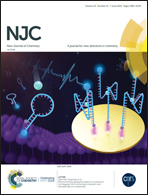Floral and lamellar europium(iii)-based metal–organic frameworks as high sensitivity luminescence sensors for acetone†
Abstract
Two europium(III)-based metal–organic frameworks (MOFs) (Eu-BDC and Eu-BTC) have been synthesized by a solvothermal method with high sensitivity. It was found that the sensitivity of both Eu-BDC (0.065 vol%), which consists of flower-like microcrystals constructed by abundant nanoparticles, and Eu-BTC (0.06 vol%), which comprises nanolayer bunches, is below the occupational exposure limit of acetone (0.075 vol%) stipulated by the American Conference of Governmental Industrial Hygienists. In addition, Eu-BDC and Eu-BTC have good chemical stability and are promising for detection of acetone content in the environment. The fluorescence-quenching mechanism for Eu-BDC and Eu-BTC may be the fluorescence inner filter effect. Furthermore, the morphology of Eu-MOFs, that is, the specific surface area and pore size distribution, may be one of the factors affecting the fluorescence intensity and sensitivity of Eu-MOFs to acetone.



 Please wait while we load your content...
Please wait while we load your content...